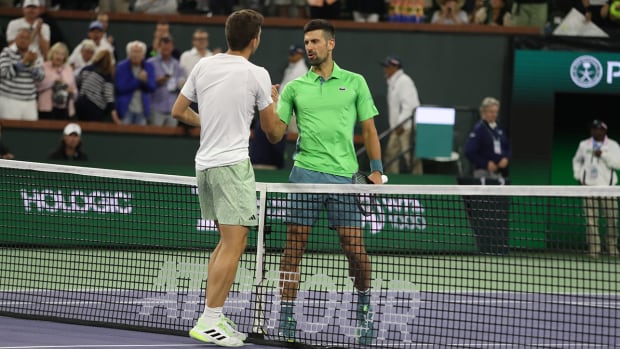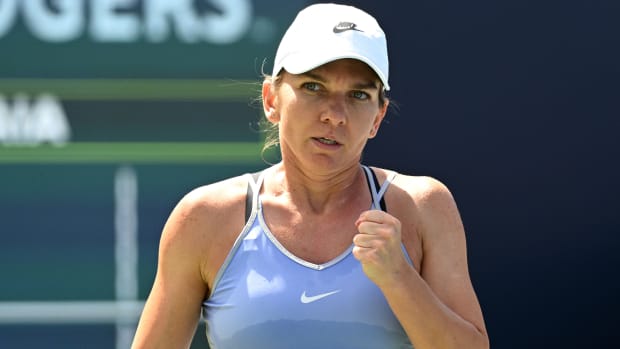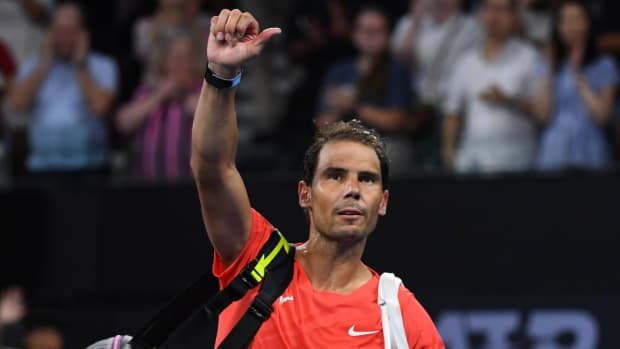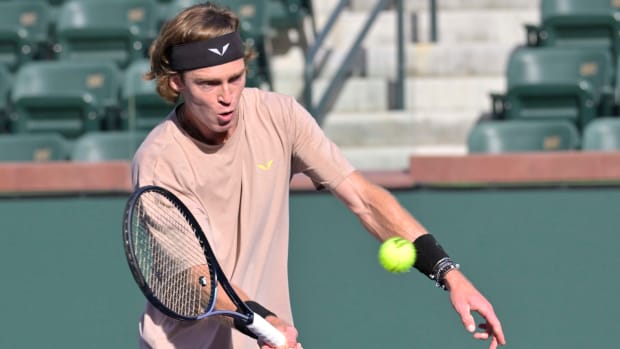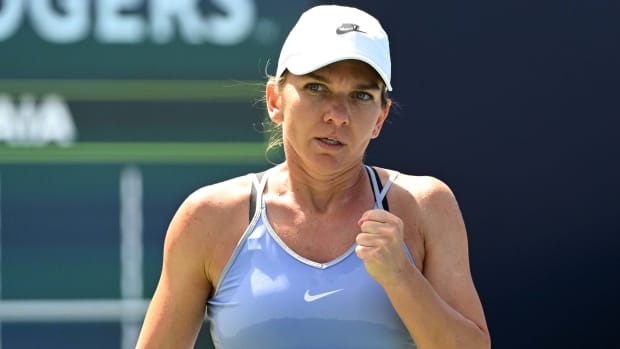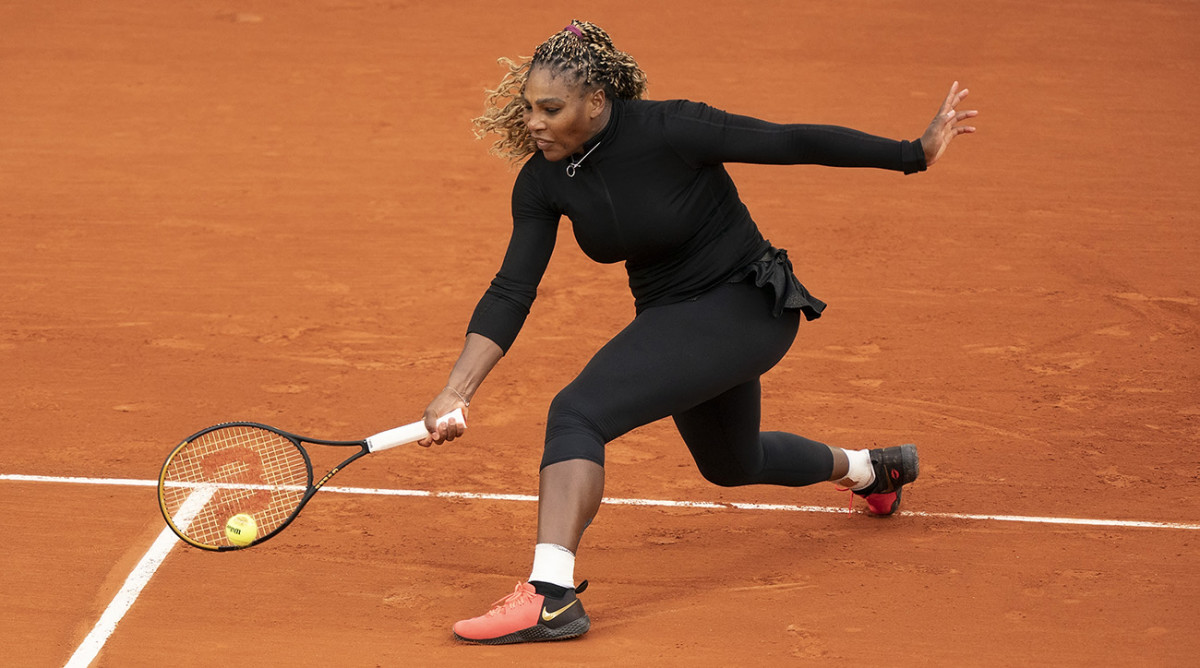
Mailbag: What's In Store for Serena Williams in 2021 as She Chases Major No. 24?
Hey, everyone:
• The most recent SI Tennis podcast featured Jenson Brooksby, the 20-year-old from Sacramento who is Karatsev-ing on the Challenger Tour.
• Next up: Katrina Adams on her new book.
• Michael Chang on ending anti-Asian hate.
• Two retirements to announce: Alex Dolgopolov and Barbora Strycova.
• Skip to the bottom for a lovely essay from periodic contributor (and full-time law professor) Ryan Rodenberg.
Onward….
Mailbag
Have a question or comment for Jon? Email him at jon_wertheim@yahoo.com or tweet him @jon_wertheim.
Hi Jon. Does Serena Williams play tennis anymore? Is she injured, practicing, or relaxing?
—Eric Bukzin, Manorville, N.Y.
• I recognize Eric’s name from previous questions, know he is a tennis fan and suspect this is at least partially tongue-in-cheek. (Tongue-in-gum?) But this is a question we get as well from casual fans and co-workers. “Is Serena still playing?” I have three answers.
1) Factually, yes. Patrick Mouratoglou posted this video just this morning. Not only playing, but playing on clay, the surface that demands the most of her and therefore will be most difficult/unlikely in her quest to win major No. 24.
2) This is what happens when you are almost 40. You pick your spots, your ranking becomes irrelevant, you prioritize the majors, you become something of a part-time player. If this is the necessary trade-off for playing for nearly half a century, so be it.
3) For all the hand-wringing, for years, about the void after Serena, it could scarcely have worked out better for the WTA. She’s become the veteran actress who legitimizes the production and draws the crowds (and financing) but other emerging stars draw the majority of the lines. That is, Serena is still this global force. But in her absence as a day-in, day-out player, we have the emergence of Met-Gala-co-host Naomi Osaka; of Ash Barty; of Iga Swiatek and Coco Gauff and Jen Brady and the rest of the colorful cast. The WTA has absolutely leaned into this as well. Go to wta.com or follow their social accounts or listen to the in-house podcasts….and you, like Eric, would wonder whether Serena was an active player. It’s almost as if she exists apart from the tour. This is not a slight. It’s more an acknowledgement that the women’s game—admiring Serena, forever in her debt—has also moved on.
February 22: "Ash, a lot of people are starting to doubt your No. 1 ranking."
Ash Barty, "Oh? Hold my beuh, will you?"
—Christopher Brown
• Well played. Yes, coming out of Australia there were murmurs that Barty’s top ranking was something less than legitimate and she was benefitting from the COVID rankings. She sure muted that discussion. Barty is playing tennis befitting the world’s best player. And we’re just talking about results (though as I write this she has won 11 of her last 12 matches, including two titles on different surfaces).
To me, Barty represents this wonderful contradiction. She is so straight and down-the-middle as a public figure. She is perfectly lovely in press conferences, but not especially quotable. She strenuously avoids any controversy. No tendentious posts on social media. She credits her team and her country and her opponents and seldom herself….And yet her tennis is, in the best way, all over the place. It’s not just that she has so much variety and so many shots. It’s that she deploys them so freely. She will subtlety change tactics. She will go games hitting only slices; and then hit only drive backhands. Some ultra-talented players—Dimitrov; early Federer—have so many options they have a hard time choosing. Barty has really mastered deployment.
Jon, long-suffering British tennis fan here. What do you think of Cam Norrie. How good can he be?
—Emily, London
• Here’s a trivia question: which men have won the most matches in 2021? As I type this, Rublev is first. No surprise there. Tsitsipas is second. No shock. Third? A tie between Jannick Sinner and ….Cam Norrie, who is 18-9 in 2021. Funny, a few weeks ago we got a similar question about Dan Evans. While Norrie is a different kind of player—a lefty, for one—I’d say there’s a similar range. Norrie is top 50 now and arrowing. But he still hasn’t won a title. (He came close last week in Estoril, reaching the finals before losing to Al Ramos-Vinolas.)
I am surprised that there has been no mention in the media about the U.S. Open men's semifinals being scheduled as two sessions beginning in 2021. I am a US Open season subscriber and was told that there would not be an increased cost for the extra session this year. I am sure in the future it will increase my costs and appears to me to be a money grab by the U.S. Open. I believe the only other Grand Slam tournament to break the men's semifinals into two sessions is the Australian Open. Remember the good old days when the men's semifinals and the women's finals were held as one session?
—Pat Long
• This has become voguish at all the majors—milk as many sessions as possible. The U.S. Open pulled off the equivalent of the Friday news dump with their announcement. Wimbledon needs to wise up: don’t publicize the end of Middle Sunday (and Manic Monday). Bury it in some unreadably boring press release, chaps!
I give the majors—even, Wimbledon, flush with insurance payout* —wide berth here. They, like many live entertainment businesses, got crushed during the pandemic. If they need to devise ways to make back some revenue, it’s understandable. Ideally some of this redounds to the players in the form of higher prize money.
We were talking about this on Tennis Channel the other day—as we were broadcasting opening matches from Madrid on a Sunday. Should more majors take the lead of the Olympics (and the French) and wrap around three weekends? More sessions for weekend sports media; more sessions for fans; more revenue to the players. If it encroaches on the finals of New Haven (RIP) or Winston Salem or some tune-up, seems like a small price to pay, no? The Majors tower above all other events. Who wouldn’t want to maximize that?
*story idea….someone ought to find both savvy AELTC employee who bought the pandemic insurance; and the insurance agent who sold it. Can you imagine how this conversation went in, say, 2018?
“Would you like an extended warranty?”
“No. Never get those.”
“Apart from general liability coverage, we can offer rainy session coverage.”
“No, we have covered courts now.”
“Good point. What about vermin coverage?”
“Nah, the hawk who scares off the pigeons keep us clear of mice and rats.”
“Oh, right. Say, we offer bee-sting protection.”
“Think we’re good there.”
“Coverage in case of lightning strikes? Sunburn? Lice outbreak?”
“Nah.”
“What about pandemic insurance.”
“Pan- what?”
“You know, like if there’s a virus that holds the world in its grip, makes impossible and causes the cancellation of Wimbledon.”
“Hmmmm.”
Coming off last week’s Barcelona title—Rafa turns 35 years old a month from today—how much longer will he play at this ELITE LEVEL?
—N.E, New Jersey
• Let's differentiate among surfaces. On concrete, Nadal’s (extreme) grip might be slipping. On clay, he is still the undisputed king (his protestations aside). Let’s also remember that, while there was once a time when 35 meant gumming your energy bars and napping in the afternoon and taking an unusually intense interest in lawn care…it now qualifies as middle age. At 34, Nadal has won the French Open without dropping a set beating Djokovic 6-0, 6-2, 7-5 in the final—and is fresh off beating Tsitsipas in Barcelona. So long as the road is covered in clay, plenty of miles left on the warranty.
Jon, I know you are big on Casper Ruud, as am I since I am from Finland. But I was disappointed to see him lose badly in his last match, 6-1, 6-2, to Basilashvili. You don’t see top players losing by scores like that. Does this suggest he still has some growing to do? What do you think of his chances at the French Open?
—Samuel, Mill Valley
• Nah, I would write this one off. This result, that is; not this player. Because of rainy conditions, Ruud had to play his quarterfinal match earlier in the day—against John Millman, who gives no quarter. When he played his semi a few hours later, he was clearly spent. I do think Ruud can be too defensive and prone to getting overhit and outhit. I think his second serve needs to be fortified. But don’t read too much into this. Speaking of Casper Ruud, his father was a pro player, which dovetails the essay coming up after one more question.
Jon, I listened to your podcast and was interested by life on the Challenger circuit. But can you put Aslan Karatsev into perspective? You (and others) always say in tennis, the margins are small. If so, why should we so surprised by his success?
—Peter C., Portland
• Sure the margins re small. Little divides, say, the No. 200 player from the No. 80 player. But Karatsev is next level disruption. We may never see another surge like this in our lifetimes. He had to qualify for Australia. And the subsequent major (2021 Roland Garros, of course) he will enter as a seed. I cannot imagine that’s ever happened before. In a sport with conventional data, I could look that up and get an answer with a few keystrokes. In tennis? “Data analysis” means pawning that off to Greg Sharko.
We’ve seen players make surprise runs deep at majors. In this millennium, someone named Martin Verkerk reached a major final. But those flashes tend to be just that: flashes. They recall those insects that mate and then die. They’ve had their moment of climax, so to speak, but then vanish. With Karatsev, he reached the semis of Australia and his results have perhaps improved since then. He won a title. He won a doubles title. He beat Djokovic. In Serbia. He left Australia ranked No. 45. He is now a match from the top 25—and, remember, defending virtually nothing, for the rest of the year. It’s not inconceivable that he starts outside the top 100…. and finishes in the top 10.
Shots, Miscellany
• Finally, periodic SI.com contributor Ryan Rodenberg closes this week’s Mailbag with a deep-dive into father-son tennis and junior player development.
Top-flight tennis bloodlines were recently on display in Tallahassee.
Three players competing in last month’s ATP Challenger Tour stop—Americans Ryan Harrison, Michael Mmoh, and Martin Damm, Jr.—share a unique trait: their fathers all played pro tennis too.
The three players also share a desire to use the Tallahassee Challenger-level tournament as a bridge to boost their rankings and qualify for upcoming Grand Slams and ATP Tour events.
“I know I am capable of playing at the [ATP] tour level and look forward to getting back there,” said Ryan Harrison, 28, after winning his first round match against Donald Young.
To get there, Harrison—who reached a career-high ranking of 40 in 2017 after winning an ATP Tour singles title in Memphis and the Roland Garros men’s doubles trophy—will tap into the player development boost he got from a decade of playing against a convenient sparring partner.
‘Blue Hamstring’
“I was twelve when I first beat my Dad,” Harrison told SI.com in a post-match interview last month. “I never lost again after that, but he was still good practice.
“I hit a growth spurt when I turned 13 or 14 and my serve was a weapon. I could hit big kick serves on the ad side up to his one-handed backhand. He would chip the return and I was able to attack, opening up the court.”
Harrison’s father, Pat, cracked the top 750 of the rankings in 1984 and is now a pro-level tennis coach in Bradenton, Florida. The two remained sparring partners for years after his son’s first intra-family victory until injuries became more commonplace.
“My Dad could lace it up and continued to play practice sets against me and other solid college players until he turned 50 and injuries set in,” said Harrison. “At one point he tore a hamstring and it turned blue.”
Elite Father-Son Tennis
According to archived records, there have only been about a half-dozen father-son duos to both crack the top 100 in the singles rankings. Two such examples include current players on tour.
Sebastian Korda—an alum of the Tallahassee Challenger who competed three years ago—is currently ranked 65 and coming off a quarterfinal finish at the ATP Tour Masters 1000 event in Miami earlier this year.
Korda’s father, Petr, was once ranked as high as number two in the world and won the 1998 Australian Open singles title.
At a career-high ranking of 22 this week, Casper Ruud from Norway also has a genetic link to tennis. Father Christian Ruud was once ranked among the world’s top 40.
“With players like Sebastian Korda and Casper Ruud, I'd say that they have that same goal [to be number one in the world], but it comes along with a better understanding of the process of how and what they have to do to get there,” tennis expert Mike Cation told SI.com via email last month while broadcasting on-site in Tallahassee. “They've already seen a lot of the world, so they're not overwhelmed by new shiny experiences.
“They also have already seen what being a professional means, the work ethic that comes along with it, and that a lot of times, it's just doing the work in the shadows.”
The tennis connections between fathers and sons occur at lower levels too.
Pandemic Practice Partner
A year ago, when all public courts in Tallahassee were closed and uncertainty swirled about the spread of Covid-19, my ten-year-old son found someone to hit with.
Me.
Years after hanging up my racquets following a short-lived return to the minor league pro tennis scene, I ventured out for two hours every day to get in a hit with him on the green ‘clay’ that is ubiquitous in Florida.
Reflex volleys, tiebreakers, groundstroke games, and overhead drills were all included during our daily sessions. We fed balls to each other to work on lobs and drop shots too. We frequently ended practice by hitting targets with our serves while taking periodic breaks for wind sprint-jump rope combos.
I did a lot of laundry during that time, with a bag of sweaty clothes daily. But the chance to take a break from remote work as a college professor and my son’s online-only school was welcome.
Indeed, another local father-son combo soon joined us.
‘Get a Win…Now’
Multi-generational tennis is an underutilized player development tool for American juniors, with no widely-available club tennis competition like that which is commonplace in Europe.
At one point in the early 1990s, there was a ‘youth versus experience’ tournament in Southern California that once featured nine-year-old Venus Williams beating 73-year-old senior tennis legend Dodo Cheney. The one-off concept was simultaneously fun and productive according to a press report obtained by SI.com, but the event did not last.
While rating systems like UTR or WTN may eventually close the gap and facilitate more friendly competition between adults and kids, it is decidedly do-it-yourself right now when getting creative for junior tennis opportunities beyond the traditional tournament structure. The benefits are abundant, especially at the father-son level.
“First, it allows the dad and son to bond in a very special way. Second, it allows the dad to transfer information to the child in a fun and relaxed environment. Third, it is a great outlet, life-long sport, and builds character,” said Lenin Mongerie of Tallahassee, who played college tennis and Davis Cup for the U.S. Virgin Islands.
Mongerie and I had a blast doing a variety of on-court drills with our two boys several months ago. At the end of one practice session, he and I decided that it would probably be prudent for us to get a doubles win on the books before our boys get too good.
“It was important to get a win against them now so when they get bigger and stronger, don't remember [losing], and they say ‘Dad, this is all you got?’ we can remind them that we asked them that once too,” said Mongerie while laughingly reflecting on our doubles triumph.
We later talked about setting up a local team match using the college tennis format with six fathers playing singles and doubles against their six sons. Merging team elements with tennis is something all ages gravitate towards.
However, unlike Ken Griffey, Sr. and Ken Griffey, Jr., who played together on the same team over the course of two Major League Baseball seasons for the Seattle Mariners, a search of archived records did not reveal any father-son doubles teams in ATP Tour or Grand Slam events.
Martin Damm, Jr. and his father could change that.
From Juniors to the Pros
Of the three players competing in Tallahassee last month who have tennis pro dads, Martin Damm, Jr. is the youngest at age 17.
“He carries himself very maturely, as you would expect from a son of a former pro,” said Mike Cation, who provided live commentary during Damm, Jr.’s three-set loss in the first round.
At six-foot-six, he also towers above his teenage peers and most adult touring pros too.
“He still has growth ahead of him, [but] it is not fair to be that big at age 17,” joked Cation during the broadcast after Damm Jr. unleased a booming serve.
Precocity aside, he has a long way to go to match his Dad’s on-court accomplishments.
Martin Damm, Sr. earned a top-50 singles ranking and a career-high doubles ranking in the top five, winning 40 tour-level doubles titles, a haul that included the US Open title in 2006 with Leander Paes.
Damm, Sr. also serves as his son’s coach, a dynamic long-time Tallahassee Challenger tournament director Karen Vogter has noticed is special among father-son tennis players.
“I certainly think that they are more free in their exchanges of their thoughts and ideas with their coaches,” explained Vogter. “And of course you do see the intimate relationship that they have with one another as father and son.”
Martin Damm, Jr. agreed.
“When I was younger at 11 or 12, I had no chance when playing sets or tiebreakers against my Dad,” he said in a phone interview last month. “But I finally started beating him regularly [after] lots of training together.
“He taught me everything…always drilling in the goal of how to form my game.”
Father-Son Squared
Father-son ties sometimes even blur between families.
During his teenage years as an upstart player on tour a decade ago, Ryan Harrison hired a new traveling coach.
“After he retired, Martin Damm, Sr. was my coach,” said Harrison. “His son used to pick up balls for us when we were training on-court.
“He was much shorter than he is now.”
